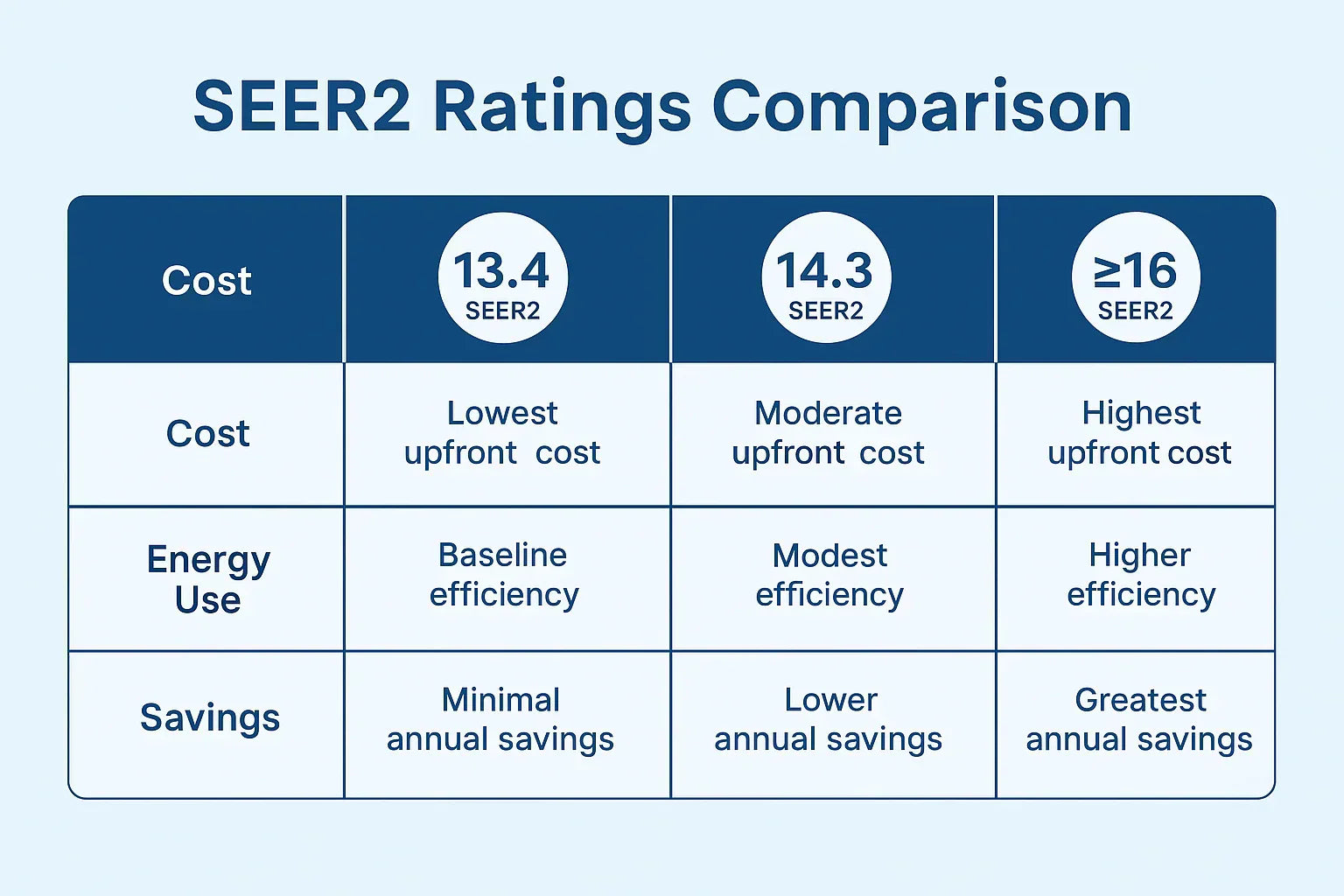If you’re shopping for a new air conditioner or heat pump in 2025, you’ve probably seen efficiency ratings like 13.4 SEER2 on equipment listings. But what exactly does that number mean? And more importantly, how does it translate into real-world savings on your monthly energy bills?
5 Ton Up To 13.4 SEER2 Goodman Air Conditioner Condenser - GLXS3BN6010
In this guide, we’ll break down what SEER2 is, why 13.4 SEER2 matters, and how it compares to older SEER ratings so you can make an informed decision about your next HVAC purchase.
What Is SEER2?
-
SEER stands for Seasonal Energy Efficiency Ratio — it measures how efficiently an air conditioner or heat pump cools your home over an entire cooling season.
-
In 2023, the U.S. Department of Energy introduced SEER2, an updated testing standard.
-
SEER2 better reflects real-world conditions by using new testing procedures that simulate ductwork and external static pressure.
-
Translation: SEER2 numbers are slightly lower than old SEER ratings for the same equipment, but they’re more accurate.
What Does 13.4 SEER2 Mean?
-
A 13.4 SEER2 system is the minimum efficiency standard for residential air conditioners in most U.S. regions as of 2023.
-
The number means the unit produces 13.4 BTUs of cooling per watt-hour of electricity consumed under the updated SEER2 test.
-
In practical terms:
-
The higher the SEER2 rating, the less energy your system uses to cool your home.
-
A 13.4 SEER2 unit is about 5–7% more efficient than the older 13 SEER standard under comparable testing.
-
How Does 13.4 SEER2 Affect Your Energy Bills?
Let’s put it in dollars.
-
Scenario:
-
2.5-ton AC system (30,000 BTU/hour).
-
Runs about 1,600 hours per year (average across many U.S. climates).
-
Local electricity cost: $0.15/kWh (national average in 2025).
-
-
Energy use comparison:
-
13.0 SEER (old standard): ~2,310 kWh/year → $346.50/year.
-
13.4 SEER2: ~2,239 kWh/year → $335.85/year.
-
-
Savings: About $10–$15 per year compared to an older 13 SEER unit.
💡 While the yearly difference seems small, these savings add up over the 10–15 year lifespan of the system.
SEER2 13.4 vs. Higher Ratings (14.3, 15.2, 16+)
-
13.4 SEER2 = baseline efficiency, most affordable upfront.
-
14.3 SEER2–15.2 SEER2 = moderate efficiency boost, typically saves an extra $20–$40/year on energy bills.
-
16+ SEER2 = high efficiency, larger upfront cost, but pays off faster in hot climates with high cooling demand.
👉 Rule of thumb:
-
If you live in the northern U.S. → 13.4 SEER2 may be sufficient.
-
If you live in the southern U.S. or areas with long summers → a higher SEER2 system may pay for itself.
Pros of Choosing a 13.4 SEER2 System
-
✅ Meets federal minimum efficiency standards.
-
✅ Lower upfront cost than high-SEER2 units.
-
✅ Ideal for homeowners with limited cooling hours per year.
-
✅ Easier to find replacement parts and widely available models.
Cons of 13.4 SEER2 Systems
-
❌ Smaller energy savings vs. higher-SEER2 units.
-
❌ May not qualify for utility rebates or tax credits (which often require SEER2 ≥ 15.2).
-
❌ Less attractive for resale in hot-climate housing markets.
How to Decide If 13.4 SEER2 Is Right for You
Ask yourself:
-
What’s your climate like?
-
Mild summers → 13.4 SEER2 is cost-effective.
-
Long, hot summers → consider 15.2+ SEER2 for bigger savings.
-
-
What’s your budget?
-
13.4 SEER2 units have a lower upfront cost.
-
Higher-SEER2 units may save you money long-term, but cost more initially.
-
-
Do rebates/tax credits matter to you?
-
Many require SEER2 ≥ 15.2, so 13.4 SEER2 systems won’t qualify.
-
The Bottom Line
A 13.4 SEER2 air conditioner or heat pump is the new baseline for efficiency in 2025. It delivers dependable performance, lower upfront costs, and modest energy savings compared to older units.
-
If you live in a mild-to-moderate climate and want the most affordable system that meets today’s standards, 13.4 SEER2 makes sense.
-
If you live in a hot, high-demand climate or want maximum savings + rebates, it’s worth looking at higher SEER2 models.
👉 Either way, understanding SEER2 helps you see beyond the sticker price — and gives you a clear view of what your energy bills will really look like.
In the next topic we will know more about: R-32 vs. R-410A: Why Goodman Switched Refrigerants (and What It Means for You)







